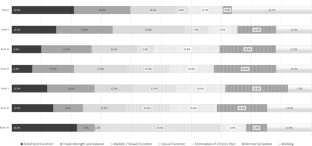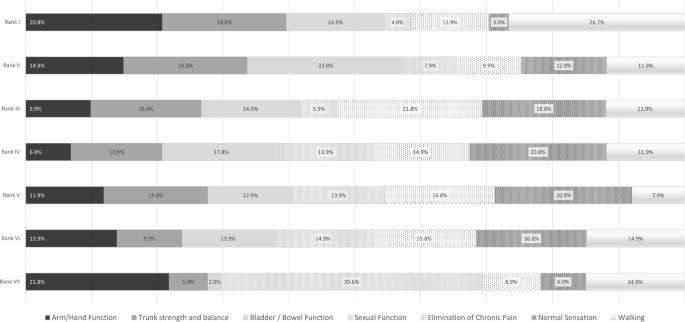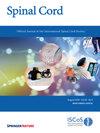脊髓损伤者的功能优先事项:沙特阿拉伯的观点。
IF 2.1
4区 医学
Q3 CLINICAL NEUROLOGY
引用次数: 0
摘要
背景/目标:脊髓损伤(SCI)患者是康复计划的决定力量,他们可以根据自己的个人偏好改善生活质量(QoL)。在此,我们旨在确定沙特 SCI 患者认为对改善其 QoL 最为重要的偏好,并探讨这些偏好是否会受到性别、教育程度、受伤时间、程度或范围的影响:设计:参与者将身体功能的七项优先事项分为 I 至 VII 级,其中 "I "为 "最重要","VII "为 "最不重要":住院康复机构:120 名患有 SCI 且无多发性创伤、后天性脑损伤、神经退行性疾病和痴呆症的男女患者(年龄大于 18 岁):结果:101 名患者(平均年龄:35 岁)中,有 7 名患者的身体机能优先级为 I 至 VII 级,其中 "I "级为 "最重要","VII "级为 "最不重要":在最终纳入的 101 名参与者(平均年龄:35.2 ± 14.8 岁)中,70.3% 为男性,66.3% 自≥ 3 岁起就患有 SCI,48.5% 完全损伤,75% 截瘫。大多数参与者(26.7%)将行走列为首要任务,其次是手/臂功能(20.8%)。性功能是最不重要的优先事项(39.6%)。手/臂功能对四肢瘫痪者的重要性明显更高(p 结论:四肢瘫痪者的首要任务是行走:在我们的沙特 SCI 患者样本中,最优先考虑的功能是行走,其次是手/臂功能,而最不需要的功能是恢复性功能。受伤时间≥ 3 年和完全性损伤的患者优先考虑的功能是行走,而四肢瘫痪患者则高度优先考虑手/臂功能。本文章由计算机程序翻译,如有差异,请以英文原文为准。


Functional priorities of individuals with spinal cord injury: a Saudi Arabian perspective
People with spinal cord injury (SCI) are the deciding force behind the rehabilitation program to improve their quality of life (QoL) based on their personal preferences. Here we aimed to determine the preferences perceived most vital by Saudi SCI population to improve their QoL, and explore if these preferences are affected by gender, education, and duration, level, or extent of injury. Participants ranked seven priorities of bodily functions as Rank I-VII with “I” being “Most important,” and “VII” being “Least important.” Inpatient rehabilitation facility. 120 participants (>18 years of age) of either sex with SCI without polytrauma, acquired brain injury, neurodegenerative disease, and dementia. Ranking scale of seven priorities of bodily functions as Rank I-VII with “I” being “Most important,” and “VII” being “Least important.” Of 101 individuals (mean age: 35.2 ± 14.8 years) finally included, 70.3% were males, 66.3% had onset of SCI since ≥ 3 years, 48.5% had a complete injury, and 75% had paraplegia. Most (26.7%) participants ranked walking as the first priority followed by hand/arm function (20.8%). Sexual function was the least important priority (39.6%). Hand/arm function was significantly more important for individuals with tetraplegia (p < 0.001). Trunk strength and balance was significantly less important for individuals with complete injury (p = 0.037). Participants with the onset of injury < 3 years and a complete injury reported bladder/bowel function as significantly more important (p = 0.011). Walking was significantly more important for people with incomplete injury and for people with injury duration ≥ 3 years (p = 0.022, p = 0.002 respectively). The top priority in our sample of Saudi people with SCI was walking followed by hand/arm function while the least desired function was regaining sexual function. Walking was a prioritized function for people with injury duration ≥ 3 years and people with a complete injury while hand/arm function was highly prioritized by people with tetraplegia.
求助全文
通过发布文献求助,成功后即可免费获取论文全文。
去求助
来源期刊

Spinal cord
医学-临床神经学
CiteScore
4.50
自引率
9.10%
发文量
142
审稿时长
2 months
期刊介绍:
Spinal Cord is a specialised, international journal that has been publishing spinal cord related manuscripts since 1963. It appears monthly, online and in print, and accepts contributions on spinal cord anatomy, physiology, management of injury and disease, and the quality of life and life circumstances of people with a spinal cord injury. Spinal Cord is multi-disciplinary and publishes contributions across the entire spectrum of research ranging from basic science to applied clinical research. It focuses on high quality original research, systematic reviews and narrative reviews.
Spinal Cord''s sister journal Spinal Cord Series and Cases: Clinical Management in Spinal Cord Disorders publishes high quality case reports, small case series, pilot and retrospective studies perspectives, Pulse survey articles, Point-couterpoint articles, correspondences and book reviews. It specialises in material that addresses all aspects of life for persons with spinal cord injuries or disorders. For more information, please see the aims and scope of Spinal Cord Series and Cases.
 求助内容:
求助内容: 应助结果提醒方式:
应助结果提醒方式:


